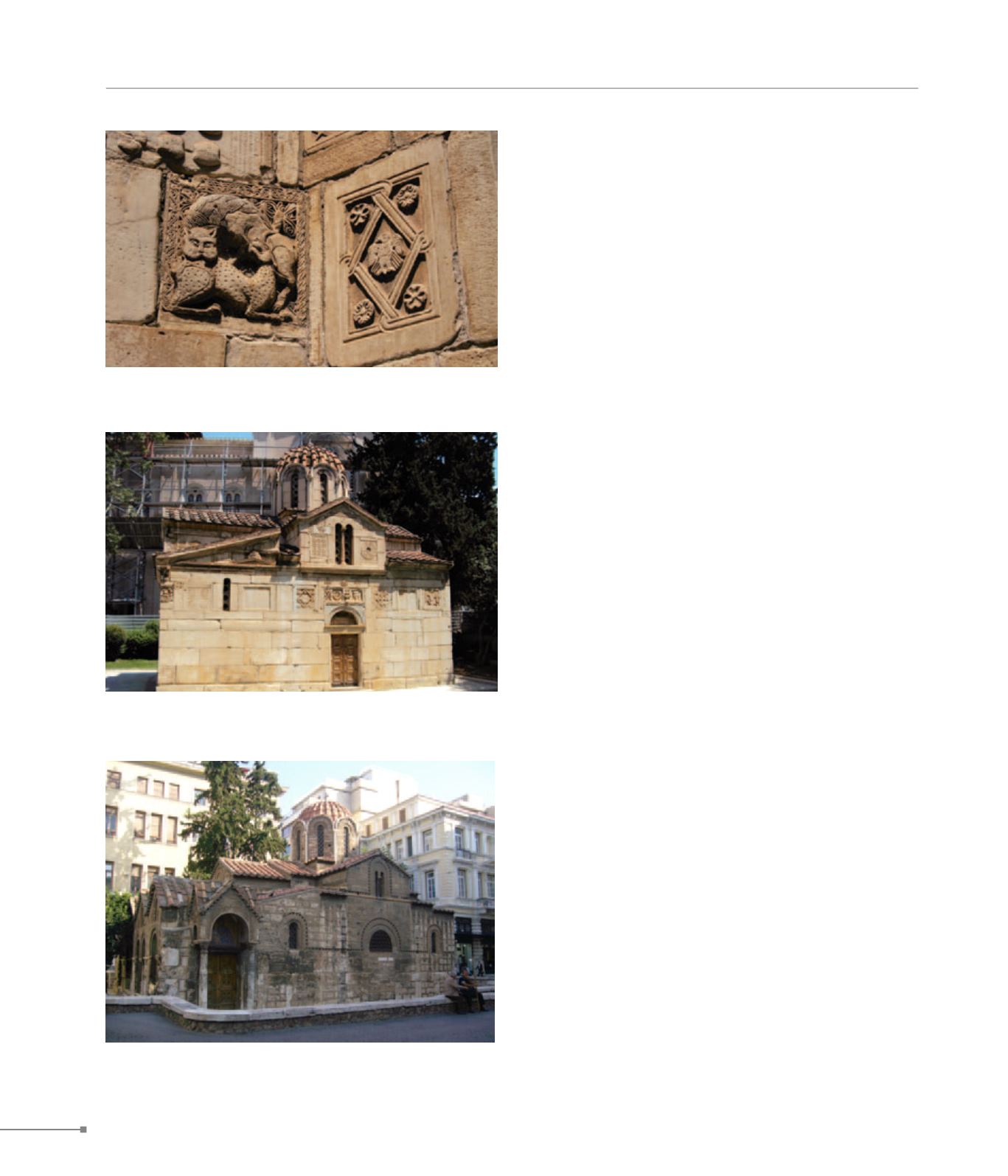
Athens. Athenai.
Athens. Athenai.
CENTRAL GREECE
198
tal’s architecture. Aghioi Apostoloi of Solakes (dated 1000) at
the ancient Agora is a cross-in-square church with narthex
and semi-circular compartments combined to form a centrally
planned structure. Its external masonry is cloisonné with numer-
ous kufic ornaments. Soteira Lykodemou in Philellinon Street is
a complex octagon church with narthex. It was built just before
1031, based on the plan of the catholicon of Hosios Loukas
monastery in Boeotia. Its external masonry is cloisonné with nu-
merous kufic ornaments and a frieze of clay tiles. There are
more Christian monuments dating from the first half of the 11th
c. that underwent significant alterations in subsequent years.
Saint Nicholas Rangavas, a four-columned cross-in-square
church with decorative brickwork and kufic elements, is placed
in the second quarter of the 11th c. Saint Catherine in Plaka
is a four-columned, cross-in-square church dating from 1050.
Kapnikarea (mid-11th c.) is a complex cross-in-square church
with later narthex and an aisleless chapel on its N side. It is
built in cloisonné masonry and, at its S entrance, preserves an
elegant porch very similar to Argolic monuments of the 12th c.
The only Athenian church dated with relative accuracy is Aghioi
Theodoroi at Klauthmonos Square, a distyle, cross-in-square
church, with a special feature in the W columns, which are not
free but joined with the W wall. On the exterior the church is
decorated with a clay relief frieze with kufic-like themes. Accord-
ing to inscriptions it was erected in 1049 or 1065 by Nikolaos
Kalomalos. Aghioi Asomatoi at Theseion is placed almost in the
same period as Aghioi Theodoroi (second half of the 11th c.). It
is a four-columned, cross-in-square church, possibly decorated
with tiles featuring kufic elements, and its present-day form is a
result of complete restoration in the late 1950s. Metamorphosis
on the N slope of the Acropolis dates from the second half of
the 11th c. and is also a four-columned, cross-in-square church
with quite a few alterations. Also built in the 11th c., the church
of Aghioi Anargyroi at Psyrri is cross-in-square with a unique
diplotholion, significantly degraded today. Saint John Theolog-
os at Plaka is a two-columned, cross-in-square church dating
from the late 11th or early 12th c., with a layer of wall paintings
of the first half of the 13th c. The church of Gorgoepikoos, a
semi-complex, cross-in-square with narthex, is a unique case
due to its all-marble exterior. Marble slabs are embedded on
its façades, as well as a frieze of re-used ancient and Byzantine
reliefs also covering the façades of the crossarms. It is believed
that the church is associated with the scholarly Metropolitan of
Athens Michael Choniates and dates from the late 12th c.
The occupation of Athens by the Franks in 1204 marked the
beginning of Frankish rule, which lasted until 1456. The de la
Roche Franks, the first sovereigns, converted the Propylaia into
a ducal palace and constructed the so-called Rizokastro to re-
inforce the defence of the Acropolis. From the churches they
erected or dedicated in a Western manner there survive only
a number of “Frankish-Byzantine” sculptures. Besides those in
Saint John Theologos at Plaka, wall-paintings from this period
have been noted in the cave church of Aghia Marina, near the
Observatory (original layer, 13th c.).
257. Athens, Kapnikarea (Αθήνα, Καπνικαρέα)
257. Athens, Gorgoepikoos (Αθήνα, Γοργοεπήκοος)
257. Athens, Gorgoepikoos, sculptures (Αθήνα, Γοργοεπήκοος, γλυπτά)


